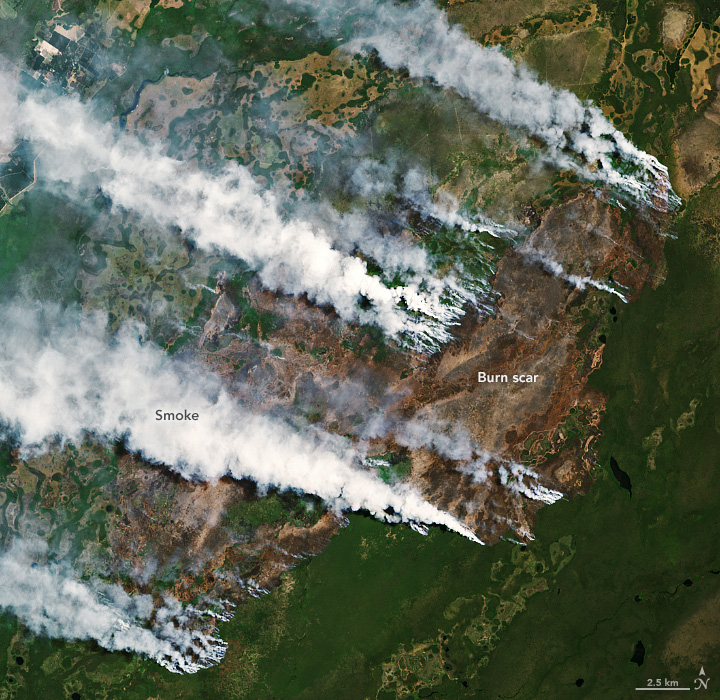

Fires blazed through a protected wilderness in northeastern Argentina in February 2023. Home to jaguars, capybaras, and giant anteaters, Iberá National Park has reportedly been burning since late December 2022, and continued to burn as of February 22, 2023.
The images above show smoke streaming from the fires on the northwest side of Iberá National Park in the Corrientes province on February 19, 2023. They were acquired by the Operational Land Imager-2 (OLI-2) on the Landsat 9 satellite. The false-color image on the right combines shortwave infrared, near infrared, and visible light (OLI-2 bands 6-5-3) to make it easier to distinguish unburned vegetated areas (green) from the recently burned landscapes (brown).
Iberá National Park is a protected area of wetlands and grasslands established in 2018 with land acquired by conservation groups and then donated to the government of Argentina. Encompassing 1,370 square kilometers (530 square miles) of the Corrientes region, the park is part of a “rewilding” program which aims to reintroduce keystone species to the oasis such as jaguars and capybaras that have previously been driven away by hunting, ranching, and other human activities.

This area of Argentina is no stranger to fires. Last year more than 520,000 hectares (1.3 million acres) were burned in the Corrientes region and surrounding provinces. In 2022 and so far in 2023, fire activity has been unusually high in the region, according to Mark Parrington, senior scientist at the Copernicus Atmosphere Monitoring Service (CAMS). The CAMS Global Fire Assimilation System uses active fire data from NASA's Moderate Resolution Imaging Spectroradiometer (MODIS) sensors to estimate emissions of vegetation fires which are then used to forecast the air quality impacts of biomass burning.
“For the second year in a row Corrientes province is experiencing much higher fire activity than experienced over the last two decades,” Parrington said. “So far this year, the fires seem to be much more localized around the Iberá wetlands compared to more widespread fires across northern Argentina and southern Paraguay in 2022.”
Although the origin of the fires is not clear, prolonged drought and high temperatures in the region have contributed to the ongoing burning. On February 13, Argentina’s National Meteorological Service issued high-temperature warnings, as temperatures reached around 40° C (104° F) in parts of central and northern Argentina. This is already the eighth heatwave in the country this summer, according to the national meteorological service. As the sweltering heat moved from southern Argentina to the north over the course of February, it broke temperature records in 27 Argentine cities.
The heat wave has exacerbated the multi-year drought in central South America. According to the World Weather Attribution (WWA) initiative, a collaboration between climate scientists in six countries, a third consecutive year of La Niña is contributing to a prolonged drought in Argentina and Paraguay. In the last three months of 2022, rainfall totals in central Argentina were the lowest in more than half a century. The lack of rain dramatically diminished yields of wheat, soybeans, and other crops.
Although La Niña is responsible for the lack of rain, human-caused climate change made the recent extreme temperatures in the region 60 times more likely, according to WWA researchers.
NASA Earth Observatory images by Lauren Dauphin, using Landsat data from the U.S. Geological Survey. Story by Emily Cassidy.